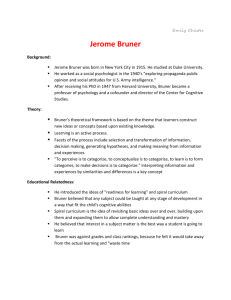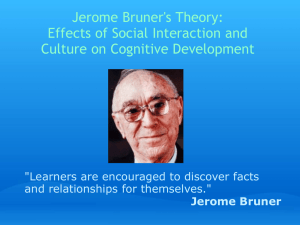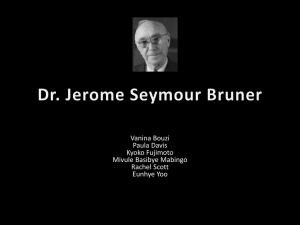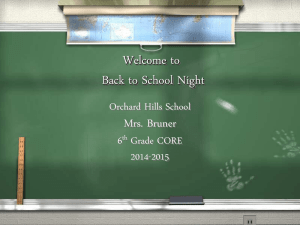Bruner - Learning Theory in Education | Simply Psychology
advertisement
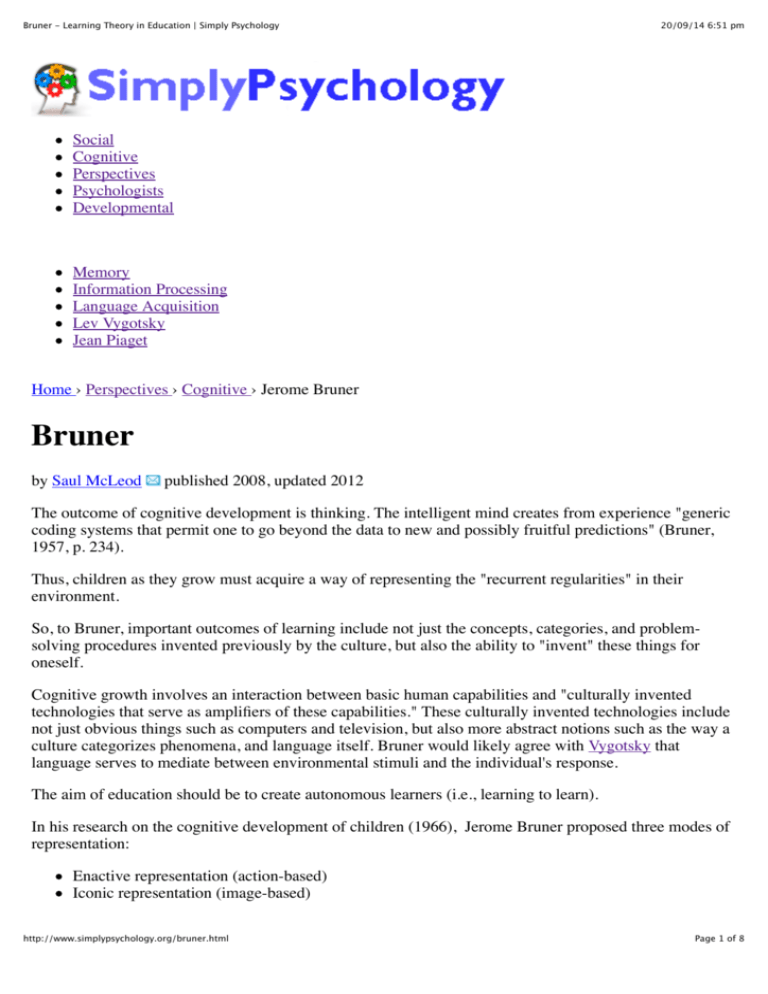
Bruner - Learning Theory in Education | Simply Psychology 20/09/14 6:51 pm Social Cognitive Perspectives Psychologists Developmental Memory Information Processing Language Acquisition Lev Vygotsky Jean Piaget Home › Perspectives › Cognitive › Jerome Bruner Bruner by Saul McLeod published 2008, updated 2012 The outcome of cognitive development is thinking. The intelligent mind creates from experience "generic coding systems that permit one to go beyond the data to new and possibly fruitful predictions" (Bruner, 1957, p. 234). Thus, children as they grow must acquire a way of representing the "recurrent regularities" in their environment. So, to Bruner, important outcomes of learning include not just the concepts, categories, and problemsolving procedures invented previously by the culture, but also the ability to "invent" these things for oneself. Cognitive growth involves an interaction between basic human capabilities and "culturally invented technologies that serve as amplifiers of these capabilities." These culturally invented technologies include not just obvious things such as computers and television, but also more abstract notions such as the way a culture categorizes phenomena, and language itself. Bruner would likely agree with Vygotsky that language serves to mediate between environmental stimuli and the individual's response. The aim of education should be to create autonomous learners (i.e., learning to learn). In his research on the cognitive development of children (1966), Jerome Bruner proposed three modes of representation: Enactive representation (action-based) Iconic representation (image-based) http://www.simplypsychology.org/bruner.html Page 1 of 8 Bruner - Learning Theory in Education | Simply Psychology 20/09/14 6:51 pm Symbolic representation (language-based) Bruner's Three Modes of Representation Modes of representation are the way in which information or knowledge are stored and encoded in memory. Rather than neat age related stages (like Piaget), the modes of representation are integrated and only loosely sequential as they "translate" into each other. Enactive (0 - 1 years) This appears first. It involves encoding action based information and storing it in our memory. For example, in the form of movement as a muscle memory, a baby might remember the action of shaking a rattle. The child represents past events through motor responses, i.e. an infant will “shake a rattle” which has just been removed or dropped, as if the movements themselves are expected to produce the accustomed sound. And this is not just limited to children. Many adults can perform a variety of motor tasks (typing, sewing a shirt, operating a lawn mower) that they would find difficult to describe in iconic (picture) or symbolic (word) form. Iconic (1 - 6 years) This is where information is stored visually in the form of images (a mental picture in the mind’s eye). For some, this is conscious; others say they don’t experience it. This may explain why, when we are learning a new subject, it is often helpful to have diagrams or illustrations to accompany verbal information. Symbolic (7 years onwards) This develops last. This is where information is stored in the form of a code or symbol, such as language. This is the most adaptable form of representation, for actions & images have a fixed relation to that which they represent. Dog is a symbolic representation of a single class. Symbols are flexible in that they can be manipulated, ordered, classified etc., so the user isn’t constrained by actions or images. In the symbolic stage, knowledge is stored primarily as words, mathematical symbols, or in other symbol systems. Bruner's constructivist theory suggests it is effective when faced with new material to follow a progression from enactive to iconic to symbolic representation; this holds true even for adult learners. A true instructional designer, Bruner's work also suggests that a learner even of a very young age is capable of learning any material so long as the instruction is organized appropriately, in sharp contrast to the http://www.simplypsychology.org/bruner.html Page 2 of 8 Bruner - Learning Theory in Education | Simply Psychology 20/09/14 6:51 pm beliefs of Piaget and other stage theorists. The Importance of Language Language is important for the increased ability to deal with abstract concepts. Bruner argues that language can code stimuli and free an individual from the constraints of dealing only with appearances, to provide a more complex yet flexible cognition. The use of words can aid the development of the concepts they represent and can remove the constraints of the “here & now” concept. Basically, he sees the infant as an intelligent & active problem solver from birth, with intellectual abilities basically similar to those of the mature adult. Educational Implications For Bruner (1961), the purpose of education is not to impart knowledge, but instead to facilitate a child's thinking and problem solving skills which can then be transferred to a range of situations. Specifically, education should also develop symbolic thinking in children. In 1960 Bruner's text, The Process of Education was published. The main premise of Bruner's text was that students are active learners who construct their own knowledge. Bruner (1960) opposed Piaget's notion of readiness. He argued that schools waste time trying to match the complexity of subject material to a child's cognitive stage of development. This means students are held back by teachers as certain topics are deemed to difficult to understand and must be taught when the teacher believes the child has reached the appropriate state of cognitive maturity. Bruner (1960) adopts a different view and believes a child (of any age) is capable of understanding complex information: "'We begin with the hypothesis that any subject can be taught effectively in some intellectually honest form to any child at any stage of development'. (p. 33)" Bruner (1960) explained how this was possible through the concept of the spiral curriculum. This involved information being structured so that complex ideas can be taught at a simplified level first, and then re-visited at more complex levels later on. Therefore, subjects would be taught at levels of gradually increasing difficultly (hence the spiral analogy). Ideally teaching his way should lead to children being able to solve problems by themselves. Bruner (1961) proposes that learners’ construct their own knowledge and do this by organizing and categorizing information using a coding system. Bruner believed that the most effect way to develop a coding system is to discover it rather than being told it by the teacher. The concept of discovery learning implies that students construct their own knowledge for themselves (also known as a constructivist approach). The role of the teacher should not be to teach information by rote learning, but instead to facilitate the learning process. This means that a good teacher will design lessons that help student discover the relationship between bits of information. To do this a teacher must give students the information they need, but without organizing for them. The use of the spiral curriculum can aid the process of discovery learning. Bruner and Vygotsky http://www.simplypsychology.org/bruner.html Page 3 of 8 Bruner - Learning Theory in Education | Simply Psychology 20/09/14 6:51 pm Both Bruner and Vygotsky emphasise a child's environment, especially the social environment, more than Piaget did. Both agree that adults should play an active role in assisting the child's learning. Bruner, like Vygotsky, emphasized the social nature of learning, citing that other people should help a child develop skills through the process of scaffolding. The term scaffolding first appeared in the literature when Wood, Bruner and Ross described how tutors' interacted with preschooler to help them solve a block reconstruction problem (Wood et al., 1976). The concept of scaffolding is very similar to Vygotsky's notion of the zone of proximal development, and it not uncommon for the terms to be used interchangeably. Scaffolding involves helpful, structured interaction between an adult and a child with the aim of helping the child achieve a specific goal. "'[Scaffolding] refers to the steps taken to reduce the degrees of freedom in carrying out some task so that the child can concentrate on the difficult skill she is in the process of acquiring'" (Bruner, 1978, p. 19). Bruner and Piaget Obviously there are similarities between Piaget and Bruner, but an important difference is that Bruner’s modes are not related in terms of which presuppose the one that precedes it. Whilst sometimes one mode may dominate in usage, they coexist. Bruner states that what determines the level of intellectual development is the extent to which the child has been given appropriate instruction together with practice or experience. So - the right way of presentation and the right explanation will enable a child to grasp a concept usually only understood by an adult. His theory stresses the role of education and the adult. Although Bruner proposes stages of cognitive development, he doesn’t see them as representing different separate modes of thought at different points of development (like Piaget). Instead, he sees a gradual development of cognitive skills and techniques into more integrated “adult” cognitive techniques. Bruner views symbolic representation as crucial for cognitive development and since language is our primary means of symbolizing the world, he attaches great importance to language in determining cognitive development. BRUNER AGREES WITH PIAGET 1. Children are PRE-ADAPTED to learning 2. Children have a NATURAL CURIOSITY 3. Children’s COGNITIVE STRUCTURES develop over time 4. Children are ACTIVE participants in the learning process 5. Cognitive development entails the acquisition of SYMBOLS BRUNER DISAGREES WITH PIAGET 1. Development is a CONTINUOUS PROCESS – not a series of stages 2. The development of LANGUAGE is a cause not a consequence of cognitive development 3. You can SPEED-UP cognitive development. You don’t have to wait for the child to be ready 4. The involvement of ADULTS and MORE KNOWLEDGEABLE PEERS makes a big difference 5. Symbolic thought does NOT REPLACE EARLIER MODES OF REPRESENTATION References Bruner, J. S. (1957). Going beyond the information given. New York: Norton. Bruner, J. S. (1960). The Process of education. Cambridge, Mass.: Harvard University Press. http://www.simplypsychology.org/bruner.html Page 4 of 8 Bruner - Learning Theory in Education | Simply Psychology 20/09/14 6:51 pm Bruner, J. S. (1961). The act of discovery. Harvard Educational Review, 31, 21-32. Bruner, J. S. (1966). Toward a theory of instruction, Cambridge, Mass.: Belkapp Press. Bruner, J. S. (1973). The relevance of education. New York: Norton. Bruner, J. S. (1978). The role of dialogue in language acquisition. In A. Sinclair, R., J. Jarvelle, and W. J.M. Levelt (eds.) The Child's Concept of Language. New York: Springer-Verlag. Wood, D. J., Bruner, J. S., & Ross, G. (1976). The role of tutoring in problem solving. Journal of Child Psychiatry and Psychology, 17(2), 89-100. How to cite this article: McLeod, S. A. (2008). Bruner. Retrieved from http://www.simplypsychology.org/bruner.html Like The Site? Follow Us! Simply Psychology google.com/+SimplypsychologyOrg Psychology articles and resources for students Follow +1 + 7,946 Follow @simplypsych 3,013 followers Comments (25) Sort by: Date Rating Last Activity Floyd Maponda · 151 weeks ago +4 really useful an article. how about providing the Educational implications of this theory.why is the knowledge of this theory relevant to teacher education? Reply tbjd · 137 weeks ago Report +1 I wish had read this useful article before I submitted my assignment, it would have help explain my position so much better. will be using for the second stage. many thanks http://www.simplypsychology.org/bruner.html Page 5 of 8 Bruner - Learning Theory in Education | Simply Psychology 20/09/14 6:51 pm Reply idk · 135 weeks ago Report -1 This artical is very useful as it explains the different stagesof cognitive development a child needs to go through in his point of view and how it relates to education these days. Also showing the difference between Piaget's theory as he related it and split the stages into sections. Reply laina shangano · 127 weeks ago Report +3 this article really helped me alot in unlocking some of the quections for my assignment, most especially when it comes to the Bruners three modes,...thanks alot Reply nash nana · 115 weeks ago Report +1 this article is really helpful and of good use. it has got relevant information.i suggest that those doing teaching, should have knowledge on these modes of representation. this article is simply lovely Reply john · 104 weeks ago Report -2 this is a very important information which i think broaden my perspectives to the theories of bruner regarding to education Reply mekfranklyn · 103 weeks ago Report +1 really nice article,I learned a lot.sure it ll help me more for my upcoming assignment.thanks guys! Reply morrisone randy · 101 weeks ago Report -1 i wish to have the educational applicability of Bruner's cognitive theory Reply shelton pukeni · 100 weeks ago Report 0 gret information and helpful data.i liked the table showing similarities and differences btwn bruner and piaget.excellent . Reply margaret · 97 weeks ago Report 0 Very useful for me as an introduction to all the theories these phychologists have come up with. Working with babies from 10mths and children up to the age of 7, I can agree and disagree; form an opinion and debate these theories, using my own experiences, evaluations/studies of children in my care, against all that has been researched, written about and discussed at length. Can't wait to write it all up!! http://www.simplypsychology.org/bruner.html Page 6 of 8 Bruner - Learning Theory in Education | Simply Psychology Reply 20/09/14 6:51 pm 1 reply · active 2 weeks ago Report 1 2 3 Next » Post a new comment Enter text right here! Comment as a Guest, or login: Name Email Displayed next to your comments. Not displayed publicly. Subscribe to None Submit Comment Further Information Lev Vygotsky Zone of Proximal Development Cognitive Approach Jean Piaget Jerome Bruner: The lesson of the story (Guardian Article) Print Friendly Article Content Modes of Representation http://www.simplypsychology.org/bruner.html Page 7 of 8 Bruner - Learning Theory in Education | Simply Psychology 20/09/14 6:51 pm Importance of Language Educational Implications Bruner and Vygotsky Bruner and Piaget References Related Articles Lev Vygotsky Zone of Proximal Development Cognitive Approach Jean Piaget © Simply Psychology → About | Privacy Policy | A-Z Index | Home | Contact | Mobile Version http://www.simplypsychology.org/bruner.html Page 8 of 8

